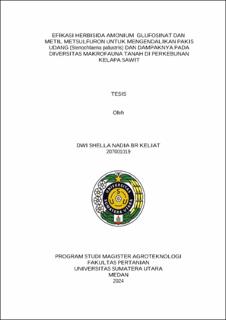| dc.contributor.advisor | Purba, Edison | |
| dc.contributor.advisor | Marheni | |
| dc.contributor.author | Keliat, Dwi Shella Nadia Br | |
| dc.date.accessioned | 2024-11-13T08:09:16Z | |
| dc.date.available | 2024-11-13T08:09:16Z | |
| dc.date.issued | 2024 | |
| dc.identifier.uri | https://repositori.usu.ac.id/handle/123456789/98771 | |
| dc.description.abstract | S. palustris belongs to the type of ferns and develops and spreads through buds, tendrils and spores. S. palustris has the ability to suppress the growth of other plants if it already dominates, because S. palustris has its roots in fibrous rhizomes and the direction of growth is creeping. Herbicides are chemical compounds applied to agricultural land to control weeds that cause degradation of production yields. Soil macrofauna is the most sensitive indicator of changes in land use, so it can be used to predict the level of land quality. The experimental design used in this study was a nonfactorial randomized group design (RAK) with 8 treatments and controls. The total research plot is 27 experimental units. The treatment plot area is 2 m x 2 m (4m²). The variables of observation carried out are percentage todamage, re-growth. Based on the percentage level of damage and re-growth indicated mixed herbicide treatment) ammonium gluotinate 375 g b.a./ha + methyl metsulfuron 40 g b.a./ha is the most effective treatment in controlling S. palustris with a high percentage of damage and a long re-growth process. The diversity and richness of soil macrofauna species before herbicide application is higher than after application with various doses of herbicides. The highest populations are Diacamma holosericum and Oecophylla smaragdina. The soil macrofauna population is low after herbicide application because the leaves of S. palustris are damaged and dry out so that the environment changes and the quality of food around is reduced or lost | en_US |
| dc.language.iso | id | en_US |
| dc.publisher | Universitas Sumatera Utara | en_US |
| dc.subject | S. palustris | en_US |
| dc.subject | Soil macrofauna | en_US |
| dc.subject | re-growth | en_US |
| dc.subject | Diversity | en_US |
| dc.subject | herbicide dosage | en_US |
| dc.title | Efikasi Herbisida Amonium Glufosinat dan Metil Metsulfuron untuk Mengendalikan Pakis Udang (Stenochlaena palustris) dan Dampaknya pada Diversitas Makrofauna Tanah di Perkebunan Kelapa Sawit | en_US |
| dc.title.alternative | Soil Macrofauna Diversity and Herbicide Efficacy of Ammonium Glufosinate and Methyl Metsulfurone Herbicides in and Mixed Manner to Control Shrimp Fern (Stenochlaena pallustris) | en_US |
| dc.type | Thesis | en_US |
| dc.identifier.nim | NIM207001019 | |
| dc.identifier.nidn | NIDN0005015905 | |
| dc.identifier.nidn | NIDN0024076504 | |
| dc.identifier.kodeprodi | KODEPRODI54111#Agroteknologi | |
| dc.description.pages | 88 Pages | en_US |
| dc.description.type | Tesis Magister | en_US |
| dc.subject.sdgs | SDGs 15. Life On Land | en_US |


